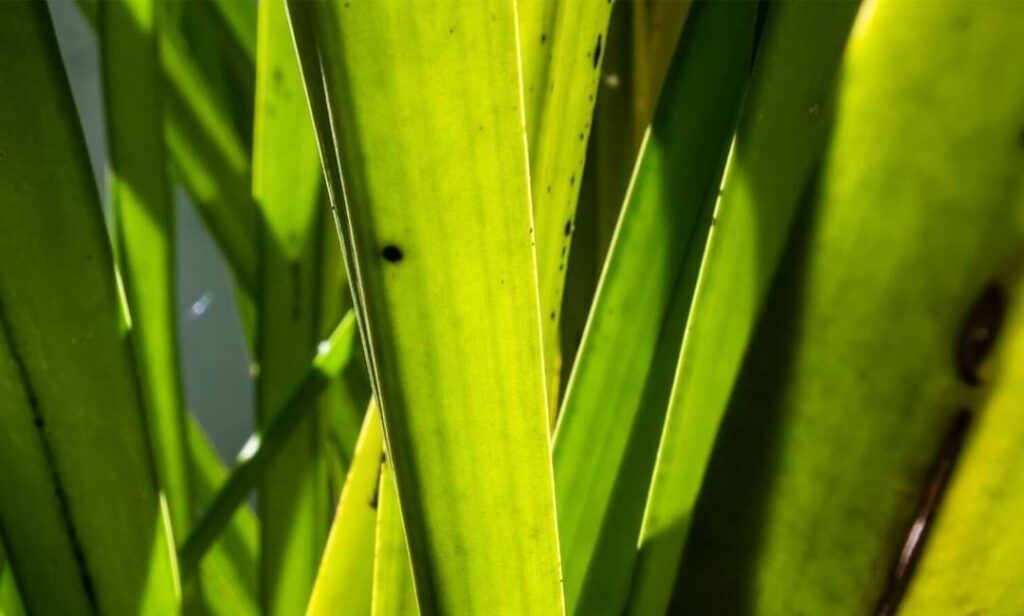Like most plants, orchids boast thick, green leaves when they’re healthy and show yellow or wilting leaves when they’re in distress. While it may be easy to tell that something is wrong with your orchid, it may not be as easy to discern what is wrong and how to fix it.
Below, we’ll dive into the 10 most common causes of orchid leaves turning yellow and reveal exactly how to keep your plant happy and healthy.
Causes of Orchid Leaves Turning Yellow
Too Much Direct Sunlight
In their natural habitat, tropical orchids grow in the dappled shade beneath thick tropical canopies. They thrive in indirect sunlight conditions and are easily harmed by direct sun rays.
Since direct sun can have a bleaching effect on light-sensitive leaves, leaf yellowing (or leaf reddening) may be a sign your orchid is receiving too much sunlight. If gone untreated, too much direct sunlight can burn your orchid and cause profound damage.
How To Fix
If you notice your orchid’s leaves turning yellow, consider where it’s positioned. If your orchid is close to a window, move it a few feet back. If your orchid is in the line of direct sunlight, reposition the plant in a room that receives bright indirect sunlight.
Another option is to hang a sheer curtain between your plant and the window or light source. This can filter harmful rays and provide just enough relief for your orchid to recover and thrive.
Too Little Light
All plants use sunlight (or artificial light) to perform photosynthesis, an energy-production process that supports healthy foliage, new blooms, and overall plant growth.
When your orchid appears limp, leggy, or shows pale, yellowing leaves, it may be suffering from too little light.
How To Fix
While it’s true that orchids can easily be harmed by direct sun rays, orchids are by no means a low-light plant, though there are low-light tolerant varieties.
If your orchid is in a dim room with little natural light, such as an office or north-facing room, you may need to reposition it so it has enough sunlight to produce new growth.
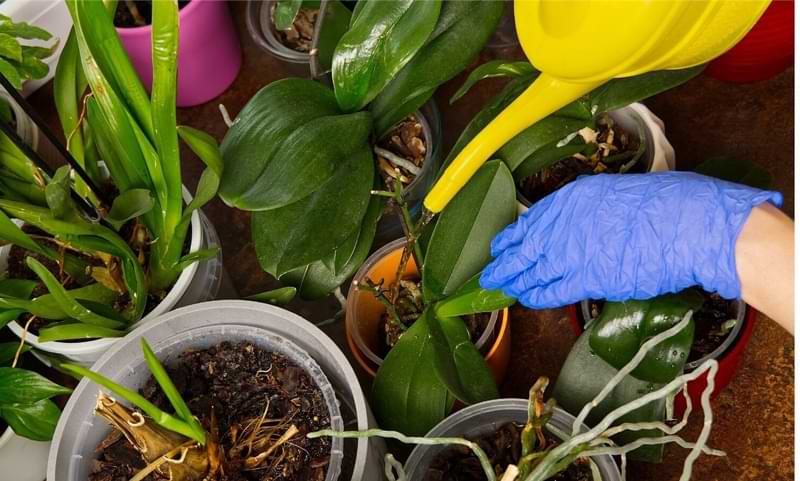

Overwatering Your Orchid
In addition to growing in dappled shade conditions, most tropical orchid species live high off the ground. Since epiphytic plants don’t require traditional ground soil to survive, they tend to grow along tree trunks and branches, often dangling their unique roots into the air so as to absorb vitamins and minerals from the nutrient-rich tropical atmosphere.
Unlike other houseplants, orchid roots require aeration to survive. So it’s common (and easy) to overwater orchids and suffocate the plant. Giving your orchid too much water can saturate the potting mix, which leaves little room for air to nourish the roots.
Overwatering can also lead to root rot, a type of plant decomposition that orchids are prone to when they sit in damp potting mix.
How To Fix
As soon as you notice your orchid’s leaf tips yellowing, pause your watering routine and let the potting mix dry thoroughly.
If your plant doesn’t perk up soon, try repotting your orchid and trimming away any damaged, blackened, or mushy roots. Upon repotting your plant, be sure to use a quick-drying potting mix to encourage water run-off and prevent water from collecting around your orchid’s roots.
Underwatering Your Orchid
While it’s true that perhaps the number-one way to accidentally kill your orchid is to overwater it, it is also possible to underwater your plant, a condition that leads to plant dehydration.
Without proper access to water, orchids can’t absorb the vital nutrients they depend on to stay happy, healthy, and produce new growth.
If your orchid is underwatered or dehydrated, you may notice signs that it’s in distress, such as wilting, softening of the main stem and leaves, wrinkled foliage, or yellowing leaves.
How To Fix
When your orchid’s leaves are turning yellow and its potting medium is thoroughly dry, try giving your plant a good watering. You can hold the plant under a running faucet until water runs through the drainage holes. Then wait for the potting mix to dry before giving the plant another drink.
It can take a few days for your orchid to perk up and recover from an underwatered state, so keep an eye on your plant for a few days after reintroducing water.
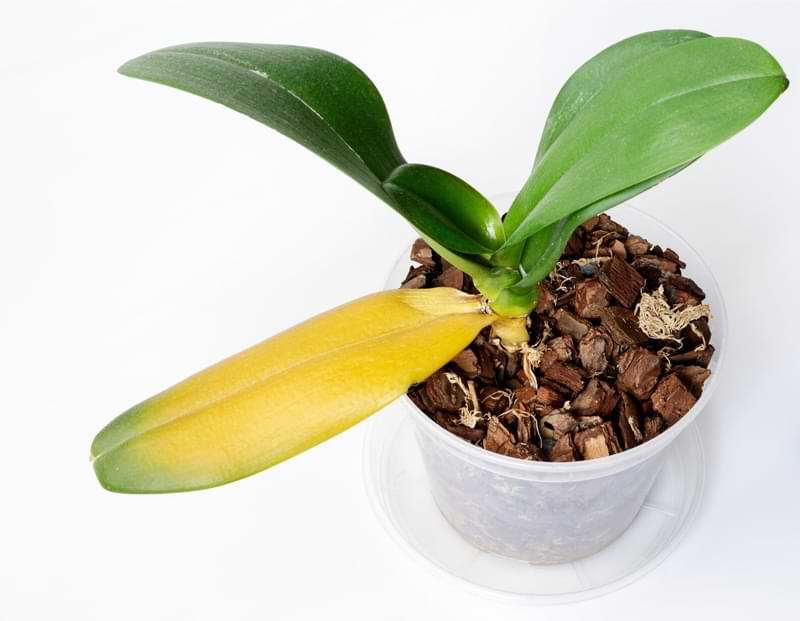

Temperature Stress
Orchids are highly sensitive to temperature changes, perhaps even more so than other tropical plants. Just a few hours after a significant rise or drop in temperature, your orchid may show yellowing leaves as a sign of distress.
For this reason, we often advise against moving your orchid from indoors to outdoors (or vice versa) unless absolutely necessary. Instead, find a place where your orchid can thrive year-round.
Typically, tropical orchids do well in indoor temperatures between 60-80 degrees Fahrenheit.
How To Fix
The most efficient way to prevent your orchid’s leaves from temperature stress is to keep its environment consistent. Be mindful of the temperatures in your home during the summer and winter months as you switch between using air conditioning and heating units.
Alternatively, you may consider investing in cooler-temperature tolerant orchid species like cymbidium and dendrobium orchids.
Humidity Levels
Like all tropical plants, orchids require humid environments to ensure they retain enough water. High humidity prevents the orchids from losing most of their internal water stores to dry air.
However, keeping your orchid’s environment properly humid can be tricky since most homeowners tend to keep their environment dry and cool, two conditions orchids don’t tolerate. Instead, orchids prefer hot, humid settings.
How To Fix
To keep your orchid properly hydrated, place it on a humidity tray so it can bask in the moist air as water evaporates from the tray. Humidity trays are relatively inexpensive, though you may choose to create your own by placing your plant in a shallow dish filled with stones or pebbles.
When a humidity tray isn’t enough, you may consider investing in a humidifier or a sensor that tracks ambient humidity levels.
Environment Change
Orchids may not respond well to environmental changes, whether small, like the amount of light in the room, or big, like seasonal shifts.
If your orchid’s leaves turn yellow immediately after you bring it home from the store, don’t panic. The transition may have shocked your plant, but if you provide it with ideal growing conditions going forward, it should perk back up.
Depending on your geographical location, you may have to reposition your plant in winter months when the duration and strength of sunlight wanes. Many growers often overlook how cold temperatures may affect orchids if they are too close to a window or heat source, such as a vent.
How To Fix
To prevent yellowing leaves from environmental changes, be sure to keep track of your orchid’s health as you make small changes to the environment. Many growers keep plant journals to track changes and monitor plant patterns.
It’s also wise to change just one environmental factor at a time, so you’ll be able to identify which change may be bothering your orchid.
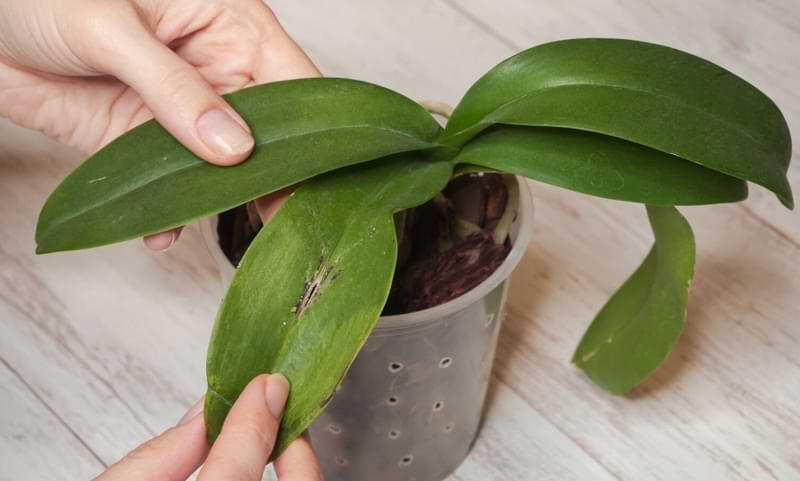

Nutrient Deficiencies
While orchids aren’t heavy feeders, they require a consistent supply of nutrients to keep their leaves lush and green and their blooms big and bountiful.
While orchid potting mix is designed to provide orchids with nutrient-rich material to feed on, it often isn’t enough to keep an orchid fully nourished. Without access to proper nutrients, orchids will yellow, go limp, or look unwell.
Additionally, some orchid fertilizers can harm your plant by providing too much or the wrong ratios of nutrients, such as calcium, manganese, zinc, copper, or phosphorus, which can prevent the uptake of iron by your orchid and lead to an iron deficiency and chlorosis, or yellowing leaves.
How To Fix
Use Premium Orchid Food to ensure your orchid is getting the proper amount of nutrients to support healthy growth, new buds, and vibrant blooms.
Premium Orchid Food is designed with your orchid’s health in mind.
- Easy application: The pre-mixed spray acts as a root stimulator for plants to improve their ability to use nutrients. This is especially important for young plants.
- Special formula: Sea kelp extract and humic acids address the unique needs of your orchid. With regular use, you’ll see healthy and vibrant orchids that grow larger year after year.
- Safe to use at every watering: The standard orchid fertilizer ratio is diluted, so it’s gentle enough to use at every watering without burning your orchid’s roots.
- It works with many orchid varieties: Premium Orchid Food is compatible with many indoor varieties, including phalaenopsis, epidendrum, Miltonia, cattleya, vanda, cymbidium, and oncidium.
For best results, simply use Premium Orchid Food every time you water. Then sit back and watch your orchid’s blooms explode.
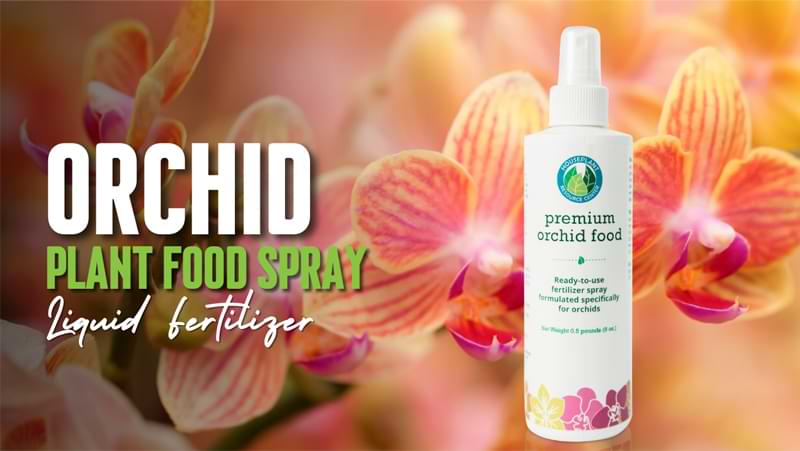

An Aging Plant
Contrary to popular belief, some leaf yellowing is natural as your orchid ages. Typically, the lowermost set of leaves turns yellow over time. This may happen more frequently as the orchid reaches the end of its life, though many orchid plants can live for decades.
As your orchid ages, it will naturally shed old leaves to make room for new ones. Should you leave the yellowing leaves to drop themselves, no harm will be done to your orchid.
How To Fix
While leaf yellowing due to aging is inevitable, you can support your aging plant by providing it with a gentle orchid fertilizer or a Root Supplement to ensure it has access to vital nutrients.
Fungal or Bacterial Infections
Fungal or bacterial infections can attack your orchid under a number of conditions. High temperatures and high humidity levels can encourage fungal spores to proliferate along your plant’s leaves, and damp potting mix can be a perfect breeding ground for bacteria colonies.
Fungal infections can sometimes present as block spots on your orchid’s leaves, while bacterial infections often present as yellowing or limp leaves.
How To Fix
If your orchid’s leaves are yellowing due to fungal infection, apply a fungicide as quickly as possible. While we recommend a commercial product to get the job done, you can try using lime or cinnamon powder to discourage the spread of fungus as well.
It’s always wise to use a sterile pair of sharp shears to remove the infected stems and leaves and repot your orchid in a fresh, dry potting mix.


Potting Stress
It’s natural to see your orchid’s roots poking out of the pot and assume your plant has outgrown its home. Orchids do, however, thrive in somewhat pot-bound conditions, and they can be quite disrupted by the repotting process.
Unnecessary repotting often leads to plant stress, so we recommend avoiding repotting your plant unless it’s necessary or once every two years.
If your orchid’s roots are growing over the lip of its pot and they are silvery or green, your plant is perfectly healthy. On the other hand, if your orchid’s leaves are yellowing and your orchid’s roots appear shriveled or gray, it’s time to repot.
How To Fix
If your orchid’s leaves are yellowing after you’ve repotted it, the plant will likely soon return to normal. The shock from the repotting process will wear off and your orchid should return to its normal state in a few days or weeks.
FAQs: Orchid Leaves Turning Yellow
Can you fix orchid leaves turning yellow?
Yes! The key to saving an orchid with yellowing leaves is to figure out what’s causing the plant’s distress and implement a proper remedy.
Nearly all of the time, yellowing leaves can be prevented and fixed, so don’t assume your plant can’t recover from yellowing leaves. The best approach is to try one remedy at a time and monitor how your plant responds.
Should I remove yellow leaves from the orchid?
There’s no harm in leaving yellowing leaves on your orchid. Eventually, the leaf will simply shrivel up and drop from the plant. Often, a new leaf will take its place.
If you do choose to trim yellow leaves from your orchid, be sure to do so with a pair of sharp, sterile shears. Remove the leaves close to the growing node to encourage new growth.
Orchid leaves turning yellow because of the kind of water I am using?
The type of water you’re using can certainly have an effect on your orchid, especially if you live in an area with hard tap water that has been treated with minerals like magnesium and calcium.
Hard tap water can affect the ability of your orchid to absorb nutrients, thus turning its leaves yellow.
To remedy this, use distilled or bottled water to water your orchid. Alternatively, you may consider investing in a water filtration system to remove excess minerals from your tap water.

